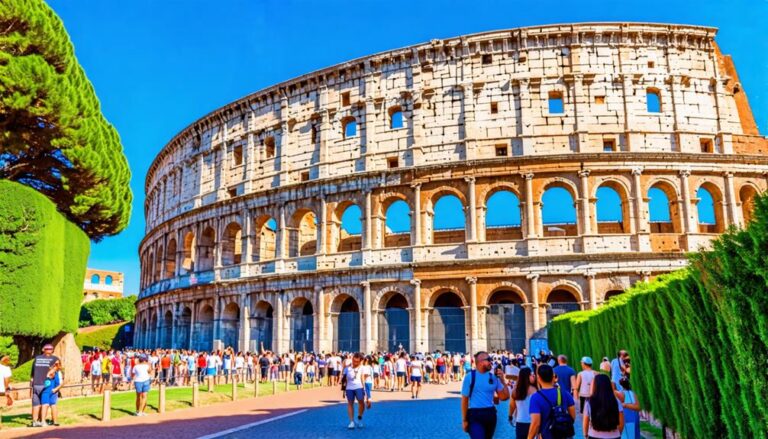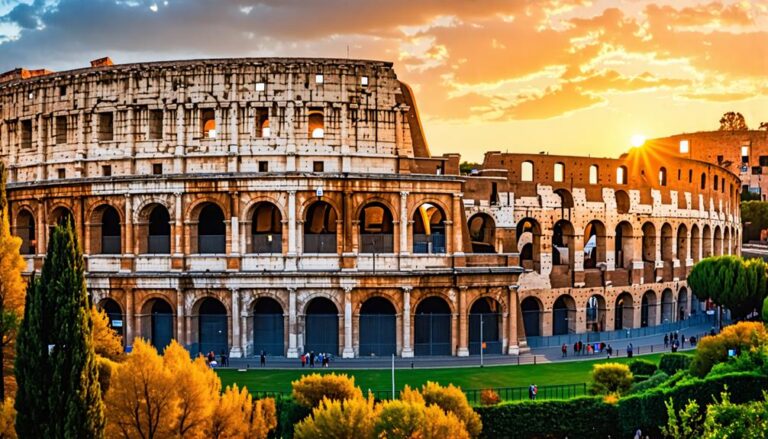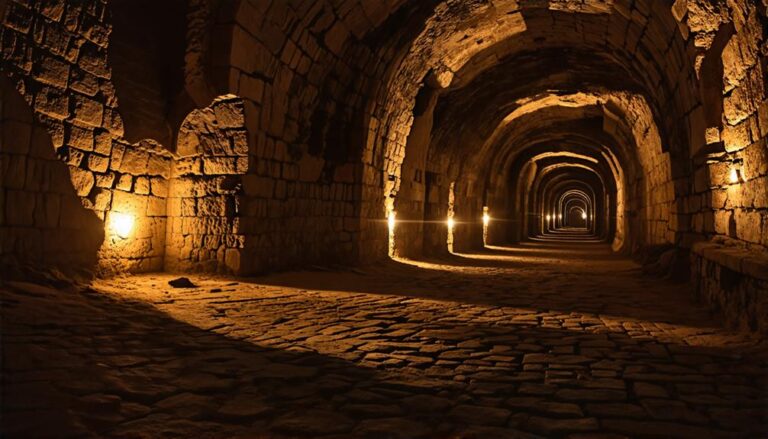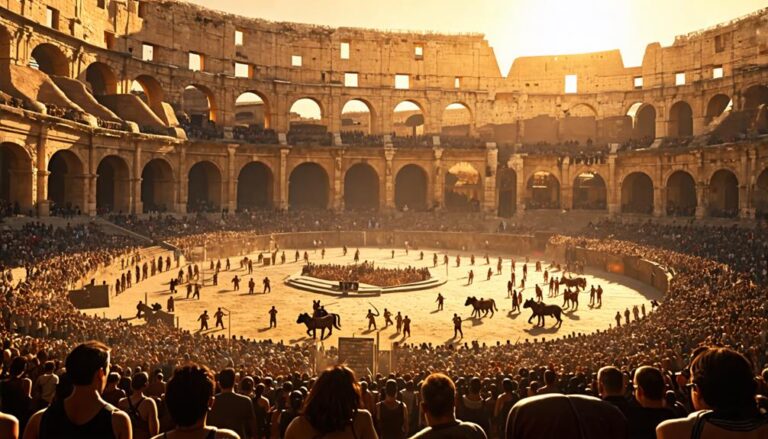History and Architecture of the Colosseum

The Colosseum, built between 70 AD and 80 AD by Emperors Vespasian and Titus, stands as a marvel of Roman engineering and architecture. Located on the site of Nero's Domus Aurea, it transformed private luxury into public spectacle.
Using 100,000 cubic meters of travertine limestone and 300 tonnes of iron clamps, the structure towers nearly 50 meters. It accommodates up to 80,000 spectators. Its elliptical design ensures excellent visibility, with seating reflecting Roman social hierarchy. Innovations such as the hypogeum and retractable velarium showcase its advanced engineering.
Visiting the Colosseum offers a glimpse into ancient Rome's grandeur. Its towering arches and intricate details are awe-inspiring. The hypogeum, an underground network of tunnels, adds to the mystery and excitement. The retractable velarium provided shade and comfort for spectators, a testament to Roman ingenuity.
For those on vacation in Rome, the Colosseum is a must-see. Its legacy as an architectural wonder and its well-preserved state make it a top attraction. Explore its history, marvel at its design, and imagine the gladiatorial contests that once took place within its walls.
Key Takeaways
When you visit Rome, the Colosseum is a must-see. Built between 70 and 80 AD by Emperors Vespasian and Titus, it stands on the site of Nero's Domus Aurea. This grand amphitheater measures 620 by 513 feet and could hold between 50,000 and 80,000 spectators. The design allows for efficient crowd movement.
The Colosseum showcases three unique architectural styles: Doric, Ionic, and Corinthian columns, each on different levels. Innovative engineering elements include arches, barrel vaults, and the hypogeum. The retractable velarium provided sun protection for spectators.
Seating arrangements reflected Roman social hierarchy. Elite citizens sat closest to the action, while the general populace was seated higher up.
Seeing the Colosseum is like stepping back in time. It's an essential part of any Roman vacation.
Origins and Founding
The Colosseum, originally called the Amphitheatrum Flavium, was built between 70 AD and 80 AD during the reigns of the Flavian Emperors Vespasian and Titus. This iconic structure stands as a symbol of Rome's resilience and revival after a period of strife. The Colosseum was constructed on the site of Nero's Domus Aurea, specifically an artificial lake. This location choice was significant; it represented the transformation of a private luxury into a public space that could host thousands.
Funding for the Colosseum came from the spoils of the Roman siege of Jerusalem during the First Jewish-Roman War. This influx of resources enabled the rapid and grand construction of the Colosseum, completed in just ten years. Its dimensions are impressive, measuring about 620 by 513 feet, and it could hold between 50,000 to 80,000 spectators. Emperor Vespasian started this grand project, but his son Titus completed it. Titus inaugurated it in 80 AD with 100 days of games, marking a new era of Roman entertainment and public life.
When planning your vacation to Rome, the Colosseum is a must-see. This historic landmark offers a glimpse into ancient Roman engineering and culture. Its massive scale and intricate architecture continue to amaze visitors from around the world. As you walk through the Colosseum, you can almost hear the echoes of the crowds and the clashing of gladiators. It's more than just a sightseeing spot; it's a journey back in time.
Make sure to book your tickets in advance to avoid long lines. Guided tours are available and highly recommended. They provide detailed historical context and fascinating insights into the lives of those who built and used this magnificent arena. Whether you're a history buff or just looking to experience one of the world's most famous landmarks, the Colosseum won't disappoint.
Purpose and Function
Vacations to Rome: Exploring the Colosseum
The Colosseum was the heart of Roman entertainment and public life. It hosted gladiatorial contests, animal hunts, and mock naval battles. This iconic amphitheater could hold between 50,000 and 80,000 spectators. Seating was arranged to reflect Rome's social hierarchy, putting the elite closest to the action.
Emperor Titus inaugurated the Colosseum in 80 AD. The opening games were extravagant, featuring 100 days of continuous events. These spectacles symbolized Rome's power and resurgence. The Colosseum's efficient design allowed 50,000 to 80,000 people to access the arena in about 15 minutes.
The hypogeum, a later addition, enhanced the drama of the events. This complex network of tunnels and chambers housed gladiators and animals, enabling their dramatic entrances and exits. The Colosseum was a marvel of engineering and a symbol of Roman grandeur. It reflected the empire's values and priorities.
Events at the Colosseum
| Event Type | Description |
|---|---|
| Gladiatorial Contests | Combat between trained fighters |
| Animal Hunts | Wild animals hunted by gladiators |
| Mock Naval Battles | Simulated sea battles |
| Public Spectacles | Various events showcasing Roman culture |
These events made the Colosseum a central hub of public life. When you visit Rome, walking through the Colosseum's ancient corridors gives you a glimpse into this vibrant past.
Architectural Styles

When you visit Rome, the Colosseum is a must-see. The grand amphitheater offers a glimpse into ancient Roman life. Each level features unique column styles: Doric, Ionic, and Corinthian designs. These styles show the evolution of classical architecture and the Romans' skill in blending beauty with function.
The Colosseum isn't just about looks. It showcases remarkable structural innovations. The use of arches and advanced building materials highlights Roman engineering ingenuity. Walking through its corridors, you can almost hear the echoes of ancient crowds.
Plan your visit to the Colosseum. It's an architectural marvel that tells a story of history and innovation.
Column Styles Breakdown
Exploring the Colosseum's Architectural Marvels on Your Rome Vacation
When you visit the Colosseum in Rome, you'll find three unique column styles, each revealing a different aspect of classical design.
On the ground floor stand the sturdy Doric columns. These simple yet strong columns symbolize the strength and resilience of the Colosseum's foundation. They provide essential support for the upper levels.
Move up to the second level, and you'll see the more decorative Ionic columns. These columns, with their scroll-like volutes, introduce an elegant element, showing a shift to a more sophisticated Roman aesthetic. The Ionic style bridges the gap between the solid Doric and the elaborate Corinthian columns.
At the third level, you'll encounter the Corinthian columns. Adorned with acanthus leaves and intricate scrolls, these columns add grandeur and elegance to the structure. They support the upper sections while enhancing the Colosseum's overall beauty.
To truly appreciate the Colosseum's architectural mastery, you should:
- Marvel at the sturdy Doric columns.
- Admire the elegant Ionic columns.
- Appreciate the beautiful Corinthian columns.
- Reflect on how these styles blend seamlessly.
Make sure to take in these details during your visit. It's a glimpse into the architectural genius of ancient Rome.
Structural Innovations Detailed
When planning a vacation to Rome, the Colosseum should top your sightseeing list. This ancient marvel showcases the sophisticated engineering prowess of ancient Rome. The Colosseum's architectural innovations, like its multi-tiered columns and advanced crowd management system, are truly remarkable.
The Colosseum features three distinct column styles. Doric columns grace the ground floor, Ionic columns decorate the second, and Corinthian columns adorn the third. These styles highlight the evolution of Roman architectural design. This blend of columns isn't just for looks; it underscores the architectural and engineering excellence that defines the structure.
Standing nearly 50 meters tall and measuring 189 by 156 meters, the Colosseum is the largest permanent amphitheater of the ancient world. Its elliptical shape ensures excellent visibility for all 50,000 spectators. Constructed with about 100,000 cubic meters of travertine stone, Roman cement, and bricks, the Colosseum's arches provide both structural support and aesthetic beauty.
A complex network of 80 entrances, including four for dignitaries, allowed for rapid entry and exit. This system ensured the entire arena could fill or empty in just 15 minutes. The retractable velarium, a canvas awning requiring about 1,000 sailors to operate, protected spectators from the sun. These features highlight Roman engineering's ingenuity, making the Colosseum a marvel in both form and function.
Building Materials
When planning a vacation to Rome, one mustn't miss the awe-inspiring Colosseum. Roman engineers used about 100,000 cubic meters of travertine limestone, tuff, and bricks in its construction. This grand amphitheater showcases their remarkable craftsmanship and resourcefulness. They sourced travertine limestone from Tibur, now Tivoli, giving the structure its majestic look and lasting durability.
To bind these massive stone blocks, they employed around 300 tonnes of iron clamps. Although many of these iron clamps have been scavenged over the centuries, leaving visible pockmarks, their initial use demonstrated the Romans' innovative approach to construction stability. The combination of tufa blocks and Roman cement provided a robust foundation, allowing for the creation of complex arches and vaults to support the vast weight of the Colosseum.
Here are four key elements that evoke its engineering marvel and lasting impact:
- Travertine limestone: Durable and visually striking.
- Iron clamps: Crucial for structural integrity.
- Tufa blocks: Lightweight yet strong.
- Roman cement: A groundbreaking binding agent.
These materials blend strength, beauty, and innovation, allowing the Colosseum to stand the test of time. The advanced construction techniques used by Roman engineers enabled quick assembly and ensured this iconic structure would endure through the ages.
When you visit, you'll witness a blend of history, architecture, and sheer ingenuity.
Construction Timeline

Exploring the Colosseum's history during a vacation to Rome reveals fascinating milestones of ancient engineering. Under Emperor Vespasian's rule around 70-72 AD, significant progress was achieved. By his death in 79 AD, the first three tiers were completed.
Emperor Titus inaugurated the Colosseum in 80 AD. Later, Emperor Domitian added enhancements in 90 AD, making the Colosseum more magnificent and functional.
When you visit, imagine the excitement during its inaugural games. Picture the grandeur of this architectural marvel as you walk through its ancient corridors.
The Colosseum stands as a testament to Rome's incredible history and the ingenuity of the Flavian Dynasty.
Key Construction Milestones
Construction of the Colosseum started in 72 AD under Emperor Vespasian. It marked the beginning of a monumental project on the site of Nero's former lake. The Colosseum became a symbol of the Flavian Emperors' power and ambition, transforming Rome and showcasing their architectural prowess. Jewish slaves, captured after the Siege of Jerusalem, did most of the labor. This highlights the harsh realities behind this grand endeavor.
Key construction milestones evoke a sense of awe and resilience:
- 72 AD: The foundation was laid, and the initial structure began to rise, setting the stage for what would become Rome's most iconic amphitheater.
- 79 AD: Under Vespasian's successor, Titus, three tiers were completed. This culminated in a grand inauguration with 100 days of games.
- 81-90 AD: Emperor Domitian expanded the Colosseum. He added a gallery and the hypogeum, enhancing both its capacity and functionality.
- Final Structure: Measuring 189 meters in length and 156 meters in width, the Colosseum's immense size is nearly double the length and 1.5 times the width of a modern football field.
These milestones reflect the Colosseum's journey from inception to completion. They illustrate the determination and ingenuity that defined one of history's greatest architectural achievements.
When planning a vacation to Rome, the Colosseum is a must-see. Its grandeur speaks volumes about ancient Roman culture and engineering. Walking through its arches and corridors, you can almost hear the echoes of the past. The Colosseum isn't just a structure; it's a testament to human ambition and resilience.
Flavian Dynasty's Role
If you're planning a vacation to Rome, the Colosseum should be at the top of your sightseeing list. This iconic structure, originally envisioned by the Flavian Dynasty, stands as a monumental symbol of Rome's grandeur.
It all began with Emperor Vespasian, who initiated the construction between 70-72 AD. He chose the site of Nero's Domus Aurea, aiming to gift the Roman Empire a grand public entertainment venue. This project not only marked a shift from tyranny but also underscored the Flavian Dynasty's commitment to the people.
Emperor Titus, Vespasian's son, completed the Colosseum in 80 AD. He celebrated its opening with 100 days of games, showcasing the amphitheatre's capacity and the dynasty's generosity. This grand inauguration cemented the Flavian Dynasty's legacy within the Roman Empire. They transformed a derelict space into an architectural marvel.
Later, Emperor Domitian, Vespasian's younger son, added further enhancements around 90 AD. He added the fourth tier and the Hypogeum, subterranean chambers that improved the Colosseum's functionality and capacity. These additions guaranteed the Colosseum's status as an iconic symbol of Roman ingenuity and imperial power.
Key Figures
Vacations to Rome Sightseeing: Exploring the Colosseum
Planning a vacation to Rome? One of the must-see attractions is the Colosseum. This ancient amphitheater stands as a symbol of Rome's grandeur and history.
Emperor Vespasian started the construction of the Colosseum. His aim was to boost public morale and restore Rome's glory. The Flavian dynasty wanted to provide grand spectacles that symbolized unity. Vespasian's vision was carried forward by his son, Emperor Titus. He completed the Colosseum and inaugurated it in 80 AD with 100 days of games. These events captivated Roman citizens and offered them an escape from daily life.
Another key figure, Emperor Domitian, made significant contributions. He added the fourth tier and the Hypogeum, enhancing the Colosseum's functionality. These additions ensured its place as a marvel of Roman engineering. It's essential to remember the countless Jewish slaves who labored to build it. They were brought to Rome after the Siege of Jerusalem.
Let's reflect on their impact:
- Vespasian: Started construction, boosting public morale.
- Titus: Completed and inaugurated the Colosseum.
- Domitian: Enhanced the structure's functionality.
- Jewish Slaves: Provided the labor, embodying the human cost.
These figures shaped the Colosseum's legacy. Their efforts intertwined freedom and power, creating an iconic symbol of Rome.
Structural Design
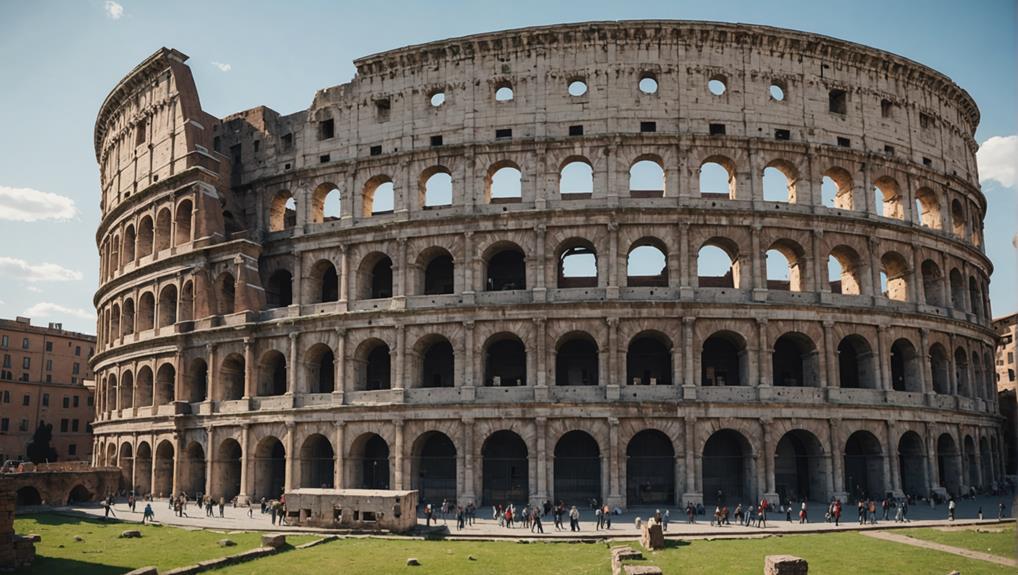
Discovering the marvels of Roman engineering, the Colosseum stands as a testament to human ingenuity. Its elliptical shape, measuring 189 meters on the main axis and 156 meters on the shorter, is not just a visual delight. This design distributes weight evenly, ensuring the structure's longevity. The Colosseum's construction used roughly 100,000 cubic meters of travertine stone, tuff, and brick-faced concrete.
The exterior boasts four levels, with the first three featuring 80 arches. These arches provide crucial support and add to the structure's beauty. The fourth level has flat panels with decorative carvings. This blend of columns, arches, and barrel vaults showcases Roman expertise in creating lasting public spaces.
Inside, the arena spans 83 meters in length and 48 meters in width. Beneath the arena lies the hypogeum, a complex network of underground tunnels. These tunnels housed gladiators and animals before their grand entrances.
| Material | Quantity (cubic meters) | Features |
|---|---|---|
| Travertine Stone | 100,000 | Durable, aesthetic exterior |
| Tuff | N/A | Lightweight, supports arches |
| Brick-faced Concrete | N/A | Strong, versatile core |
The retractable awnings, known as the velarium, provided essential sun protection. This innovative feature adds to the Colosseum's awe-inspiring design.
Visiting the Colosseum is a must for anyone on vacation in Rome. It offers a glimpse into the past and a chance to marvel at one of history's greatest architectural achievements.
Interior Layout
When planning your vacation to Rome, the Colosseum is a must-see. This iconic amphitheater showcases the grandeur of ancient Roman architecture. Let's delve into its interior layout and understand what made it so special.
The arena's vast dimensions are striking. It measured about 189 meters long and 156 meters wide. Designed to hold around 50,000 spectators, the Colosseum's seating tiers reflected Roman social hierarchy. Elite members of society sat closest to the action, while the common folk had seats higher up. This seating arrangement wasn't just for comfort; it was a clear display of social status.
Corridors and stairs formed a complex network, allowing spectators to move efficiently through the structure. This design helped manage the large crowds. Beneath the arena, the hypogeum added a dramatic element. This underground area housed gladiators and wild animals before they appeared in the arena.
The combination of these elements made the Colosseum both functional and awe-inspiring. Visiting this historic site offers a glimpse into the grandeur of ancient Rome and its architectural ingenuity.
Arena and Seating Tiers
The Colosseum's interior layout, with its vast arena and meticulously tiered seating, tells the story of ancient Roman society. The arena floor measures 83 meters in length and 48 meters in width. It was a stage for gladiatorial battles and spectacles, covered in sand to absorb blood and provide traction. The seating arrangement mirrored Roman social status, ensuring everyone knew their place.
Surrounding the arena is a formidable 10-foot wall, creating a clear boundary between performers and the audience. Our ancestors designed the seating in three main tiers, each reserved for distinct social classes.
- The podium: Closest to the action, reserved for senators and elite citizens.
- The gradatio: Positioned above the podium, accommodating the equestrian class.
- The porticus: The highest level, where the general populace sat, offering a more distant view of the events.
These divisions weren't just practical; they were a powerful statement of societal order. With a capacity ranging from 50,000 to 80,000 spectators, the Colosseum was a monumental expression of Roman engineering and social structure. Each tier represented a microcosm of the broader hierarchical world outside.
When you visit Rome, touring the Colosseum is an unforgettable experience. As you walk through this ancient amphitheater, you can almost hear the roar of the crowd and the clash of gladiators. The Colosseum stands as a testament to Rome's grandeur and complexity.
Hypogeum and Tunnels
When you visit Rome, the Colosseum stands as a must-see marvel. Beneath its grand arena and perfectly tiered seating lies the hypogeum, a maze of tunnels and chambers that redefined Roman entertainment. Built after the Colosseum's opening in 80 AD, this underground network allowed smooth movement for gladiators and animals, changing the nature of the games.
The hypogeum had 80 vertical shafts connecting to the arena. These shafts enabled dramatic entrances, enhancing the excitement for the audience. Emperor Domitian later expanded the hypogeum, adding large moving platforms called hegmata to transport creatures to the arena floor. This intricate design housed animals and equipment and provided spaces for performers to prepare.
The table below highlights key features of the hypogeum:
| Feature | Description |
|---|---|
| Vertical Shafts | 80 shafts connecting to the arena for dramatic entrances |
| Hegmata | Large moving platforms for transporting animals and props |
| Expansion by Domitian | Enhanced the hypogeum for more complex and grand performances |
This underground structure made mock naval battles impractical, marking their end. The Colosseum's focus shifted to creating awe-inspiring and innovative spectacles, showcasing Rome's commitment to grand entertainment.
When you explore the Colosseum on your Roman vacation, you'll not only see an architectural wonder but also step into a piece of history that brought unparalleled excitement to ancient audiences.
Social Class Segregation
When you visit the Colosseum in Rome, you'll notice its design reflects the social hierarchy of ancient Rome. The Emperor and the senatorial nobility had the best seats, closest to the arena. This elite group occupied the podium, a prime spot symbolizing their power and influence. Just above them, the gradatio hosted the Equestrians, a wealthy and influential class, yet still below the top tier. The general populace, including women and enslaved individuals, found their place in the porticus, the highest and furthest section from the action.
This seating arrangement wasn't just for better views. It was a deliberate way to reinforce social classes. The Colosseum's design included:
- 80 entrances: Four main ones for leaders and 76 for ordinary citizens.
- Three distinct tiers: Podium, gradatio, and porticus.
- Controlled access: Corridors ensured minimal interaction between different social groups.
- Massive capacity: Seating for 50,000 to 80,000 spectators, emphasizing societal divisions.
This structured layout guaranteed that even during public spectacles, the social hierarchy stayed clear and unchallenged. Each stone and stair echoed the divisions that defined Roman life, a stark reminder of the freedoms we now cherish.
The Hypogeum
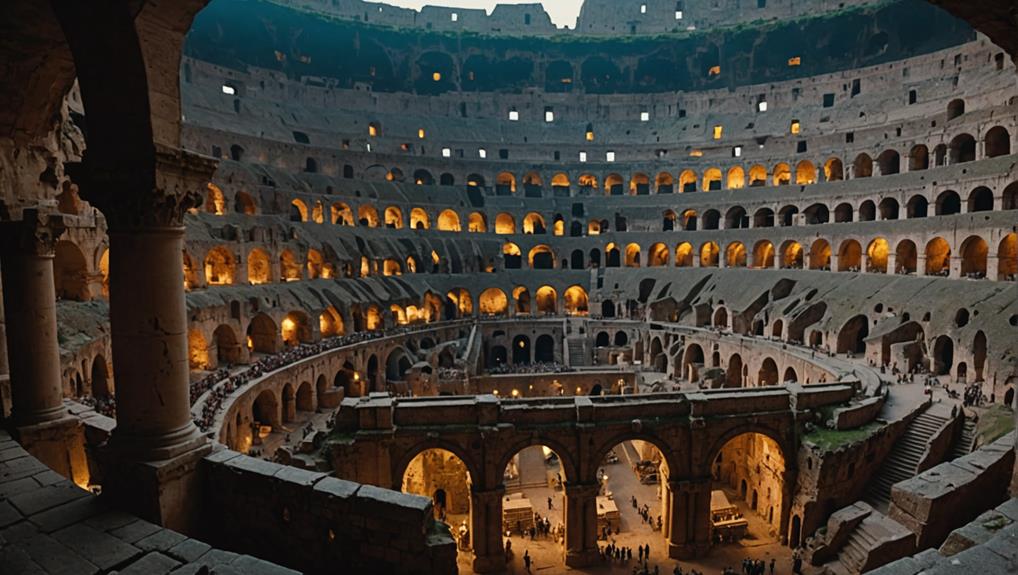
Imagine standing in the Colosseum, knowing that just beneath your feet lies the Hypogeum. This labyrinth of tunnels and chambers once held gladiators and animals, all awaiting their turn to enter the arena. Emperor Domitian added this intricate substructure after the Colosseum's inauguration in 80 AD. It revolutionized Roman spectacles. The Hypogeum wasn't in the original design. It was introduced to enhance the Colosseum's functionality, showcasing Roman engineering brilliance.
The Hypogeum features 80 vertical shafts. These shafts allowed for dramatic and unexpected entrances of combatants and beasts. They connected the underground to the arena, enabling a seamless flow of participants and props. Large moving platforms, known as hegmata, transported animals and other stage elements. This added surprise and excitement.
The Hypogeum's sophisticated system of lifts and trap doors made events run smoothly. This subterranean network provided necessary staging and housing areas. Every event captivated the audience. The Hypogeum stands as a monument to Roman architecture and engineering ingenuity.
When you visit Rome, the Colosseum is a must-see. Its underground Hypogeum adds layers to the experience. You can almost hear the echoes of history as you stand above this ancient marvel.
Social Hierarchy
When visiting Rome, the Colosseum stands as a must-see wonder. Its ancient architecture and historical significance offer a glimpse into the grandiosity of Roman society. The seating arrangement within the Colosseum paints a clear picture of the social hierarchy of ancient Rome.
The closer you were to the arena, the higher your status. The Emperor and senatorial nobility had the best views. Each tier of the cavea reflected the rigid Roman social structure, making every public spectacle a visual reminder of societal roles.
The seating was systematic:
- The Podium: Reserved for the elite, including the Emperor and senators.
- The Gradatio: Occupied by the equestrians, a class just below the senatorial rank.
- The Porticus: Filled with the general populace, farthest from the action.
- Separate Entrances: 80 entrances facilitated segregation, with four main ones for leaders and dignitaries.
This structured seating ensured the elite maintained their elevated status while the lower classes stayed in their designated areas. Corridors and access routes were meticulously planned to prevent interaction between different social groups.
So, the Colosseum wasn't just a venue for entertainment. It was a powerful tool that reinforced the social hierarchy and power dynamics of ancient Rome, reminding everyone of their place in society.
When you explore the Colosseum, you walk through history. You can almost hear the roar of the crowd and the clash of gladiators. It's more than a tourist spot. It's a step back in time, a chance to witness the grandeur and complexity of Roman civilization.
Engineering Innovations
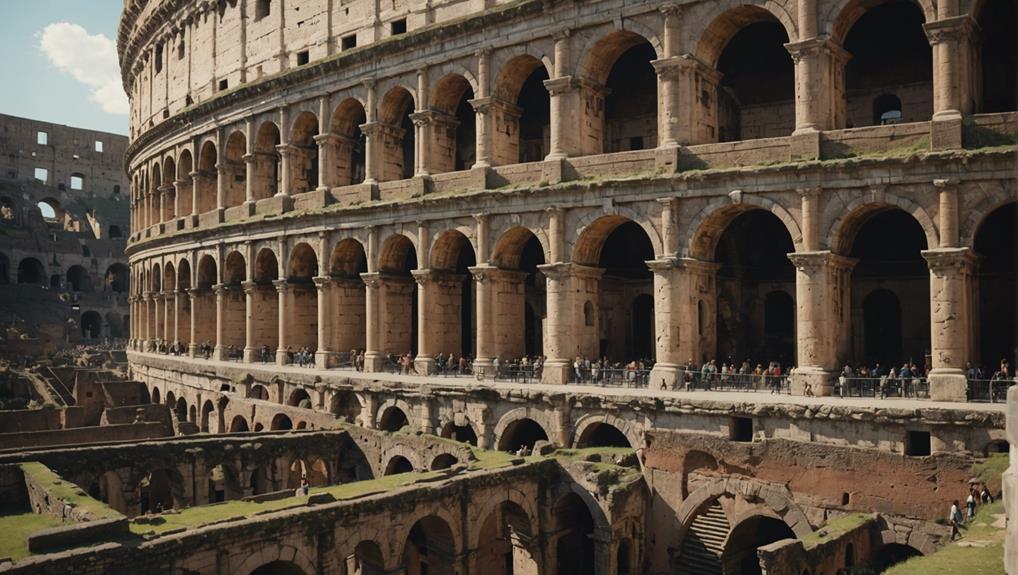
Exploring the Colosseum in Rome offers more than just a glimpse into ancient history; it's a journey through remarkable engineering feats. The Colosseum's design used arches and barrel vaults. These features gave it both stability and grandeur. The arches distributed weight efficiently, allowing it to support thousands of spectators safely.
One of the most fascinating aspects is the hypogeum. This underground network of tunnels and chambers housed animals and gladiators. Vertical shafts allowed smooth movement to the arena. It shows the advanced planning and execution of Roman engineers.
| Feature | Function |
|---|---|
| Arches and Vaults | Provided structural stability and aesthetic appeal |
| Hypogeum | Housed animals and gladiators, facilitated arena access |
| Roman Concrete | Guaranteed durability and allowed for larger structures |
Roman concrete was another significant innovation. This material allowed for larger, more durable structures. This contributed to the Colosseum's longevity. An effective drainage system managed rainwater, ensuring the arena's functionality during events.
The retractable velarium, a massive canvas awning, showcased Rome's ingenuity. Operated by a thousand sailors, it provided sun protection for spectators. It was a remarkable blend of engineering and human coordination. These innovations highlight why the Colosseum remains a symbol of Rome's architectural prowess.
Preservation Efforts
Preserving the Colosseum has been a focus since the 19th century. Continuous efforts help maintain its structural integrity and historical significance. Major restoration projects started in the 1990s to combat pollution and environmental wear. These efforts are ongoing, addressing structural damage and ensuring this magnificent structure stands tall for future generations.
The Colosseum isn't just an ancient building; it represents our shared cultural heritage. Research studies are crucial, especially those examining local underground construction's impact on the Colosseum's stability. These studies guide our strategies, ensuring we adopt the best measures for its longevity.
Funding for preservation comes from tourism revenue and government grants. This highlights the Colosseum's economic importance as a tourist attraction. As a UNESCO World Heritage Site and one of the New Seven Wonders of the World, preserving the Colosseum is vital for educational purposes and cultural pride.
Here's what drives our passion for preservation:
- Cultural heritage: Protecting the legacy of ancient Rome.
- Educational value: Teaching future generations.
- Economic impact: Boosting tourism revenue.
- Historical significance: Honoring our past.
When you visit Rome, the Colosseum stands as a must-see landmark. Its towering arches and ancient stones tell a story of a bygone era. Imagine walking through the same passages where gladiators once roamed. Picture the grand arena filled with spectators.
Rome offers many attractions, but the Colosseum is special. Its preservation efforts make sure you can appreciate this marvel in all its glory. Every visit supports its upkeep and helps protect a piece of history. So, when planning your vacation to Rome, make the Colosseum a top priority. It's more than a sight; it's a journey through time.
Frequently Asked Questions
Who Was the Architect of the Roman Colosseum?
We don't know the exact architect of the Colosseum. This grand structure showcases Ancient Roman engineering brilliance. The Flavian Amphitheatre design was a collaborative effort by skilled craftsmen and engineers. They worked under Emperor Vespasian's direction and his son, Titus, completed it.
When you plan your vacation to Rome, the Colosseum is a must-see. This iconic landmark offers a glimpse into the grandeur of ancient Rome. Its colossal structure and historical significance make it a fascinating site for all visitors.
What Are 5 Facts About the Colosseum?
The Colosseum embodies ancient Rome's grandeur. This iconic landmark showcases advanced construction techniques, featuring a massive travertine stone structure. It highlights the cultural significance of gladiatorial games, reflecting Roman society's values. The Colosseum's impressive seating capacity accommodated thousands, making it a bustling hub of ancient Roman entertainment. Visitors today can feel the echoes of history within its walls.
When planning a vacation to Rome, visiting the Colosseum is a must. You'll be amazed by the sheer scale and architectural prowess of this ancient amphitheater. Imagine the roar of the crowd and the clash of gladiators as you explore its storied corridors. The Colosseum offers a tangible connection to the past, making it a highlight of any Roman sightseeing adventure.
Why Was the Colosseum Built in an Oval Shape?
The Colosseum's oval design enhances the spectator experience, ensuring everyone has a great view. This shape also provides structural stability, distributing weight evenly and making this massive, multi-tiered amphitheater a true engineering marvel.
When you visit Rome, the Colosseum should be at the top of your sightseeing list. This iconic structure, built in 70-80 AD, served as the grand stage for gladiatorial combats and public spectacles. Its unique shape allows for optimal crowd control and efficient exit routes, making it not only visually striking but also practical.
Imagine standing where ancient Romans once cheered. The Colosseum's architectural brilliance is evident in its arches, columns, and the intricate network of underground passages. Each of these elements contributes to its enduring legacy.
While exploring Rome, take a moment to appreciate the historical significance of the Colosseum. This monument isn't just about its grandeur; it's a testament to Roman ingenuity and their quest for perfection in both form and function. So, pack your bags and immerse yourself in the grandeur of ancient Rome at the Colosseum!
What Is the Art History of the Colosseum?
What makes the Colosseum's art history so fascinating? We see stunning Colosseum mosaics, intricate frescoes, and impressive sculptures that reflect Rome's grandeur. These masterpieces remind us of the artistic freedom and cultural richness of ancient Rome.
When you plan a vacation to Rome, the Colosseum is a must-see. Imagine walking among these ancient relics, feeling the history beneath your feet. The mosaics, with their vibrant colors, tell stories of gladiators and emperors. The frescoes, though faded, still depict scenes of Roman mythology and daily life. Sculptures, carved with exquisite detail, showcase the skill of Roman artisans.
A visit to the Colosseum is more than sightseeing. It's a journey back in time. It's an exploration of human creativity and resilience. Every corner of the Colosseum whispers tales of a civilization that valued art and culture. So, when you book your trip to Rome, make sure the Colosseum is at the top of your list. It's not just a monument; it's a testament to the enduring spirit of ancient Rome.
Conclusion
Exploring the Colosseum in Rome is a must for any vacation. This iconic amphitheater, built with remarkable ingenuity, symbolizes Roman engineering and societal structure. The Hypogeum, the complex underbelly of ancient spectacles, reveals the intricate planning behind the events held here.
The Colosseum's enduring legacy highlights the balance between human achievement and the passage of time. Visiting this monumental site underscores the importance of preserving our heritage for future generations.
When planning your sightseeing in Rome, the Colosseum should top your list. Its grandeur, from the towering arches to the detailed stonework, offers a unique glimpse into ancient Roman life.
The structure's preservation efforts make it possible for us to witness this marvel today.
